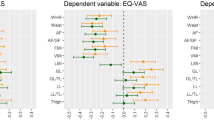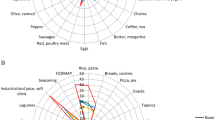Abstract
Objective:
We hypothesized that chocolate preference would be related to health and psychological well-being in old men.
Design, setting and participants:
We have followed up a socio-economically homogenous group of men, born in 1919–1934, since the 1960s. In 2002–2003, a mailed questionnaire was used to assess the health and well-being (including questions related to positive life orientation, visual analogue scales and the Zung depression score) of survivors. In addition, candy preference was inquired. Those men who reported no candy consumption (n=108) were excluded from the analyses.
Outcome measures:
Psychological well-being in old age.
Results:
The response rate was 69% (1367 of 1991). Of the respondents, 860 and 399 preferred chocolate and other type of candy, respectively. The average age in both candy groups was 76 years. Of the respondents, 99% were home-dwelling, 96% were retired and 87% were presently married, without differences between the candy groups. Men preferring chocolate had lower body mass index and waist circumference, and they also reported more exercise and better subjective health (P=0.008) than other candy consumers. Variables related to psychological well-being were consistently better in those preferring chocolate. The differences were statistically significant in feeling of loneliness (P=0.01), feeling of happiness (P=0.01), having plans for the future (P=0.0002) and the Zung depression score (P=0.02).
Conclusions:
In this socioeconomically homogenous male cohort, chocolate preference in old age was associated with better health, optimism and better psychological well-being.
Sponsorship:
The Academy of Finland, the Päivikki and Sakari Sohlberg Foundation, the Helsinki University Central Hospital and the Finnish Foundation for Cardiovascular Research.
This is a preview of subscription content, access via your institution
Access options
Subscribe to this journal
Receive 12 print issues and online access
$259.00 per year
only $21.58 per issue
Buy this article
- Purchase on Springer Link
- Instant access to full article PDF
Prices may be subject to local taxes which are calculated during checkout

Similar content being viewed by others
References
Aalto A-M, Aro AR, Teperi J (1999). RAND-36 as a Measure of Health-Related Quality of Life. Reliability, Construct validity, and Reference Values in the Finnish General Population. Helsinki: Stakes. Research Reports 101.
Ariefdjohan MW, Savaiano DA (2005). Chocolate and cardiovascular health: is it too good to be true? Nutr Rev 63, 427–430.
Arts IC, Hollman PC (2005). Polyphenols and disease risk in epidemiologic studies. Am J Clin Nutr 81, 317S–325S.
Brown J, Bowling A, Flynn T (2004). Models of quality of life: a taxonomy, overview and systematic review of the literature. European Population Forum for Ageing Research Bristol, London.http://www.ageingresearch.group.shef.ac.uk/pdf/qol_review_complete.pdf Accessed 3 September 2006.
Buijsse B, Feskens EJM, Kok FJ, Kromhout D (2006). Cocoa intake, blood pressure, and cardiovascular mortality. Arch Intern Med 166, 411–417.
Ding EL, Hutfless SM, Ding X, Girotra S (2006). Chocolate and prevention of cardiovascular disease: a systematic review. Nutr Metab 3, 2.
Engler MB, Engler MM (2006). The emerging role of flavonoid-rich cocoa and chocolate in cardiovascular health and disease. Nutr Rev 64, 109–118.
Ferri C, Grassi D, Grassi G (2006). Cocoa beans, endothelial function and aging: an unexpected friendship? J Hypertens 24, 1471–1474.
Fisher NDL, Hollenberg NK (2006). Aging and vascular responses to flavanol-rich cocoa. J Hypertens 24, 1575–1580.
Franco OH, Bonneux L, de Laet C, Peeters A, Steyerberg EW, Mackenbach JP (2004). The Polymeal: a more natural, safer, and probably tastier (than the Polypill) strategy to reduce cardiovascular disease by more than 75%. BMJ 329, 1147–1150.
GO. GO Findings (2005). Growing Older. The ESRC Research Programme on Extending Quality of Life (Webmaster Marg Walker July 2005) http://growingolder.group.shef.ac.uk/GoFindings.htm Accessed 3 September 2006.
Hays RD, Morales LS (2001). The RAND-36 measure of health-related quality of life. Ann Med 33, 350–357.
Hertog MG, Feskens EJ, Hollman PC, Katan MB, Kromhout D (1993). Dietary antioxidant flavonoids and risk of coronary heart disease: the Zutphen Elderly Study. Lancet 342, 1007–1011.
Keli SO, Hertog MG, Feskens EJ, Kromhout D (1996). Dietary flavonoids, antioxidant vitamins, and incidence of stroke: the Zutphen Study. Arch Intern Med 156, 637–642.
Marmot M, Shipley M, Brunner E, Hemingway H (2001). Relative contribution of early life and adult socio-economic factors to adult morbidity in the Whitehall II study. J Epidemiol Community Health 55, 301–307.
Martin CT, Kayser-Jones J, Stotts N, Porter C, Froelicher ES (2006). Nutritional risk and low weight in community-living older asults: a review of the literature (1995–2005). J Gerontol 61A, 927–934.
Miettinen TA, Huttunen JK, Naukkarinen V, Strandberg T, Mattila S, Kumlin T et al. (1985). Multifactorial primary prevention of cardiovascular diseases in middle-aged men. Risk factor changes, incidence, and mortality. JAMA 254, 2097–2102.
Miller KB, Stuart DA, Smith NL, Lee CY, McHale NL, Flanagan JA et al. (2006). Antioxidant activity and polyphenol and procyanidin contents of selected commercially available cocoa-containing and chocolate products in the United States. J Agric Food Chem 54, 4062–4068.
Mortensen EL, Jensen HH, Sanders SA, Reinisch JM (2001). Better psychological functioning and higher social status may largely explain the apparent health benefits of wine. Arch Intern Med 161, 1844–1848.
Parker G, Parker I, Brotchie H (2006). Mood state effects of chocolate. J Affect Dis 92, 149–159.
Pearson DA, Holt RR, Rein D, Paqlieroni T, Schmitz HH, Keen CL (2005). Flavanols and platelet reactivity. Clin Dev Immunol 12, 1–9.
Pitkala KH, Laakkonen ML, Strandberg TE, Tilvis RS (2004). Positive life orientation as a predictor of 10-year outcome in an aged population. J Clin Epidemiol 57, 409–414.
Rimm EB, Stampfer MJ (2002). Wine, beer, and spirits. Are they really horses of a different color? Circulation 105, 2806–2807.
Schroeter H, Heiss C, Balzer J, Kleinbongard P, Keen CL, Hollenberg NK et al. (2006). Epicatechin mediates beneficial effects of flavanol-rich cocoa on vascular function in humans. Proc Natl Acad Sci 103, 1024–1029.
Strandberg TE, Strandberg A, Salomaa VV, Pitkala K, Miettinen TA (2003). Impact of midlife weight change on mortality and quality of life in old age. Prospective cohort study. Int J Obes Relat Metab Disord 27, 950–954.
Strandberg TE, Strandberg A, Rantanen K, Salomaa VV, Pitkala K, Miettinen TA (2004). Low cholesterol, mortality and quality of life in old age during a 39-year follow-up. J Am Coll Cardiol 44, 1002–1008.
WHO. WHOQOL-BREF (2003). Introduction. Administration, scoring and generic version of the assessment. Field Trial Version December 1996. In: Rapley M (ed). Quality of Life Research. A Critical Introduction. Sage Publications: Thousand Oaks, CA, USA.
Zung W (1965). A self-rating depression scale. Arch Gen Psychiatry 12, 63–70.
Acknowledgements
Ethical approval: The research project has been approved by the Ethical Committee of the Department of Medicine, University of Helsinki. This work was funded by Finnish Foundation for Cardiovascular Research, the Sohlberg Foundation.
Author information
Authors and Affiliations
Corresponding author
Additional information
Guarantor: TE Strandberg.
Contributors: TES, AYS, KHP and TAM have contributed in the conception and design, or acquisition of data, or analysis and interpretation of data. TES, AYS, KHP, VVS, RST and TAM drafted the article and revised it critically for important intellectual content. TES, AYS, KHP, VVS, RST and TAM approved the final version to be published.
Rights and permissions
About this article
Cite this article
Strandberg, T., Strandberg, A., Pitkälä, K. et al. Chocolate, well-being and health among elderly men. Eur J Clin Nutr 62, 247–253 (2008). https://doi.org/10.1038/sj.ejcn.1602707
Received:
Revised:
Accepted:
Published:
Issue Date:
DOI: https://doi.org/10.1038/sj.ejcn.1602707
Keywords
This article is cited by
-
Effect of chocolate on older patients with cancer in palliative care: a randomised controlled study
BMC Palliative Care (2022)
-
Happiness of the oldest-old men is associated with fruit and vegetable intakes
European Geriatric Medicine (2018)
-
Clinical and laboratory characteristics of active and healthy aging (AHA) in octogenarian men
Aging Clinical and Experimental Research (2015)
-
Response to Chocolate, well-being and health among elderly men: chocolate and acute myocardial infarction in a case–control study from Italy
European Journal of Clinical Nutrition (2009)



